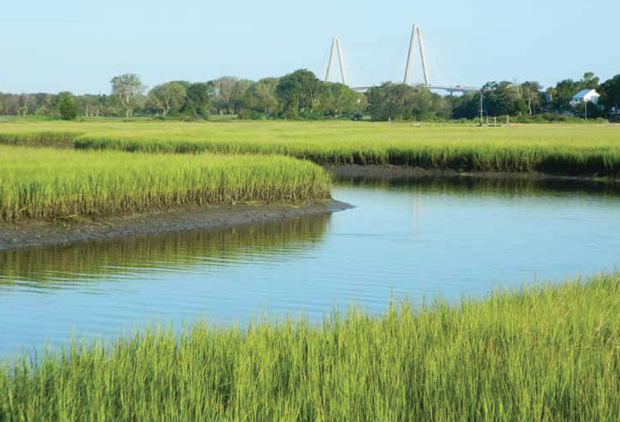The Jewel of Mount Pleasant
22 Sep 2018
A picture of coastal living perfection, Shem Creek has a rich history from its original name to its ever-changing businesses
By SUZANNAH SMITH MILES

With its picturesque shrimp trawlers, impressive saltwater marshes and an ever-present gaggle of camera-ready pelicans and porpoises, Mount Pleasant’s Shem Creek is ranked as one of the most photographed places in the state. Well it should be, for it is one of those rare spots where man and nature have managed to successfully coexist, side-by-side, for centuries.
The creek is not only picture-puzzle scenic, it boasts a history as old as the coast, itself. For thousands of years up until European settlement, this was a principal waterway of the Sewee, the coastal Indian tribe who lived along the seacoast from Charleston harbor to the Santee River. Their name for the creek (and perhaps the surrounding land) was “Shemee.” While the meaning of the word is long lost, the sheltered deep water, excellent fishing and easy accessibility to the harbor was as important to the Sewee as it was for the Englishmen who began settling in this area in the 1680s.
As ownership changed over time, the creek took on different names. Captain Florence O’Sullivan (for whom Sullivan’s Island is named) was one of the first to own lands on the east side of the creek and in the 1680s the creek became known as “Sullivan’s Creek.” Likewise, it was “Dearsley’s Creek” when Captain George Dearsley had a shipyard here in the 1690s. It became “Parris’ Creek” for Colonel Alexander Parris who owned Hogg Island at the creek’s mouth (today’s Patriots Point) and in the 1760s it was “Lempriere’s Creek” for Captain Clement Lempriere who also built ships here. For a brief period during the early 1800s it was referred to as Distillery Creek for a short-lived beer distillery built along the western shore. At some point the Sewee name “Shemee” became shortened to “Shem” and the name remains with us today.
From the outset, the creek was recognized as ideal for shipbuilding. The first to establish a yard there was likely Captain George Dearsley, whose main plantation was at Hobcaw but whose landholdings stretched all the way to the creek. An early mention of this is found in a contemporary account of the 1706 French-Spanish Invasion, when French ships carrying Spanish soldiers from St. Augustine threatened an attack on Charles Town. Landing soldiers on the mainland (today’s Old Village), it was noted that the soldiers “ranged there among the plantations, burning houses and plundering as far as Mr. Dearsley’s Creek, where they burned upon the plantation, the store-house, Captain [Jacob] Saltus’ ship, and a new ship upon the stocks.”
That “new ship upon the stocks” definitely refers to a ship being built, perhaps under Dearsley’s purview. Captain Clement Lempriere’s shipyard was active in the 1760-1770s. All manner of vessels were built there, from brigantines and sloops to the Planter, a steam vessel built in the 1850s that gained fame during the Civil War as the Confederate transport boldly taken by its African-American pilot, Robert Smalls, and turned over to the Union Navy. In more recent times, E. O. Hall’s shipyard was active in the late 1890s and early 1900s, followed by Darby’s Shipyard, which remained on the creek for almost a hundred years.
Throughout the course of history, many businesses have been active on the creek. In the 1740s, Peter Villepontoux had a lime kiln on the creek, an all-important business during the building boom in Charleston during that period. In 1795, Jonathan Lucas, famous for creating the first steam-driven rice mill, an invention that revolutionized the processing of raw rice, used his Shem Creek lands (today’s Shemwood) to build the first water-driven combination rice and saw mill for public use. In the 1850s, John Hamlin had a bucket factory on the east side of the creek that provided an assortment of lumber, wooden buckets and brooms to the Lowcountry market.
One well-known endeavor was Hibben’s Ferry, which operated from Haddrell’s Point on the southeast side of the creek’s mouth. While Andrew Hibben is generally remembered in history as establishing the first ferry service from Shem Creek in the 1770s, the accolade rightfully goes to Captain Henry Gray, who obtained a charter in 1747 to operate a ferry from the plantation his wife had inherited from her father, Peter Villepontoux. This plantation, called Fair Spring, was purchased by Peter’s father Zachariah Villepontoux in 1741 and incorporated most of O’Sullivan’s original lands. It was sold in 1764 to Jonathan Scott, who established Greenwich Village, the first of Mount Pleasant’s old villages. In the midst of this was a 50-acre tract owned by Jacob Motte who established a plantation called “Mount Pleasant” in 1765, from which the town was eventually named.
The introduction of shrimp trawlers to the creek came in the 1930s with Captain William C. Magwood and his boat, “Skipper”—the first engine-powered trawler on the creek. From that point onward the creek became the home port for an active fleet of shrimp trawlers and fishing vessels. For decades, literally dozens of working boats lined both sides of the creek, so many they often had to dock three or four abreast and could be seen all the way from the bridge to the creek’s mouth at the harbor. There were few residences. The land was entirely taken up by docks and packing houses that served the seafood industry. Darby’s Shipyard was still active, situated on the same lands that Dearsley had his shipyard in 1695. Today this is fronted by deep water docks used by shrimp trawlers.
Considering its centuries of continued use, the creek continues to thrive with a remarkable natural healthiness. Shem Creek is not only deep, but tidally influenced. Each changing tide flushes in a huge rush of water carrying the requisite nutrients that feed the shrimp, crabs, fish and shellfish that live in the creek’s waters and marshlands. These creatures in turn provide food for a healthy population of herons, egrets, gulls, pelicans, larger fish and the schools of porpoise who feed in the creek’s waters.
Moreover, the creek doesn’t end just past the bridge. It meanders onward for about a mile, just past Bowman Road where it meets Highway 17 North. The creek narrows, of course, but the marshlands surrounding it are wide and surprisingly healthy given today’s population density.
Shem Creek is a rare combination of history, beautiful natural environment and human activity. It has been a mainstay for the people who have lived on East Cooper lands for over three hundred years. It is a jewel to be treated with caution and respect in our 21st century rush around development and an increasing population. Shem Creek is a treasure we should all preserve, uphold and look on with pride.












